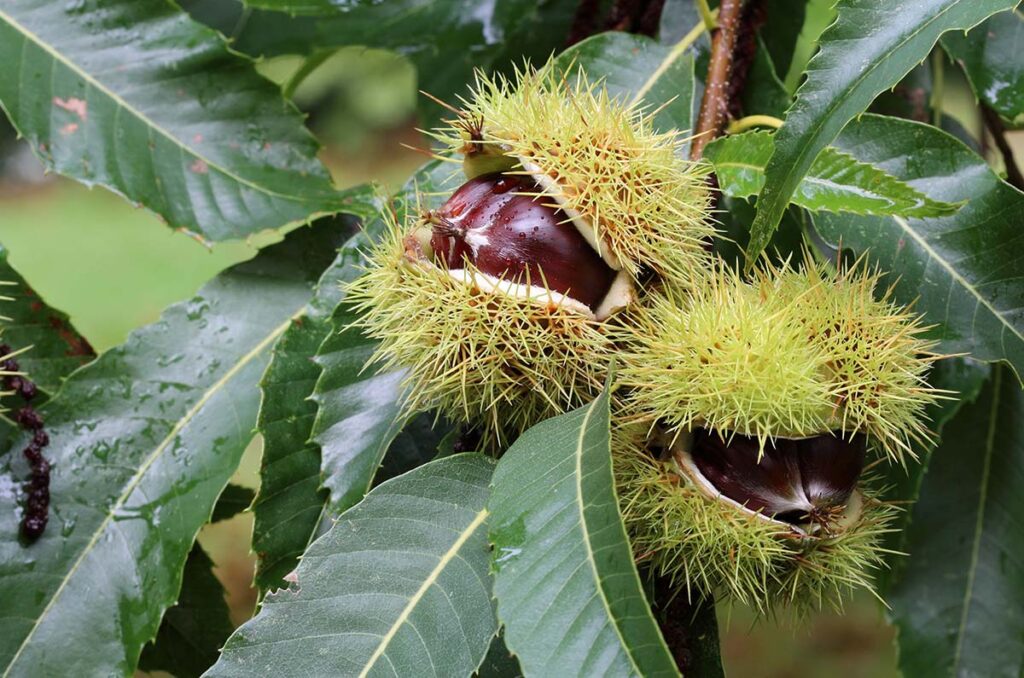Fall ’25 Bare-Roots – Order Now – Farm Pickup or Shipping Starts 11/24
Fall ’25 Bare-Roots – Order Now – Farm Pickup or Shipping Starts 11/24
|

We are excited to announce the launch of a new biochar agroforestry research project thanks to the generous support of the USDA’s Sustainable Agriculture Research and Education (SARE) program. The grant supports the exploration and promotion of “novel approaches” to productive agricultural systems that enhance the ecosystems in which they reside. The project will test the potential of biochar to improve soil health, carbon sequestration, and tree productivity of chestnuts and other tree crops. Previous research has shown significant productivity gains with the use of biochar, but most with annual crops. There is a lack of research into biochar’s effects on perennial crop systems, which is what our project seeks to address. You can access the grant proposal here.

Biochar is made from superheating biomass in the absence of oxygen – a process called pyrolysis. This converts the biomass into a stable form or carbon that is highly porous and absorptive. The process also releases a significant amount of energy in the form of biogas and heat, which can be used in place of fossil fuels to heat or power auxiliary buildings or operations.
Biochar gained attention with the discovery of ancient carbon-rich Amazonian soils that are believed to have been created through human activity. Anthropogenic soils have been discovered around the world, from the lands of the Australian Aborigines to the raised “plaggenesch” in Germany dating back to neolithic times.
We don’t know for sure whether the practice of adding char to the land was an intentional effort to enrich the soils or just a way of discarding domestic waste. What we can determine, though, is how significantly the practice enhances plant health and productivity, as previous research and anecdotal evidence shows. We can also quantify how much carbon can be sequestered with its widespread use.

Our experiment will test four different biochar and compost treatments (along with a native soil control) on 120 hybrid chestnut trees, interplanted with black locust, on an upland field with low soil organic matter on the edge of the Mid-Hudson Wildlife Corridor. Fields like this are typical of our area, having been actively farmed in orchard, pasture, and hay for at least 250 years. These areas are most suitable as forest or in production systems that incorporate trees and other perennial plants – an approach to farming known as agroforestry, which is more traditionally found in tropical climates than temperate ones.
Increasing focus on climate resilience is expanding interest in agroforestry practices in our region and across the country.

An essential ingredient to expanding adoption of innovative farming methods is convincing farmers it’s worth their while. One of the great values of the SARE program is that it supports applied science with practical applications in real world settings that farmers can relate to. For this project, we have gathered a group of ten farms to participate in the trials and to provide feedback on whether and how farmers might expand use of biochar in their operations.
Partners include: Adamah Farm, Beavertides Farm, Big River Chestnuts, Breadtree Farm, Propagate Ventures, Samascott Orchards, Shaker Creek Farm, Whistledown Farm, Woven Stars Farm, and Yellowbud Farm.
Our Project Advisory Committee includes Dan Carr of Berkshire Agricultural Ventures, Jono Neiger of the Regenerative Design Group, and Jake Samascott of Samascott Orchards. Our science team includes Dr. Will Britton of Woods End Laboratories and Dr. Juan Alvez at the University of Vermont’s Center for Sustainable Agriculture.